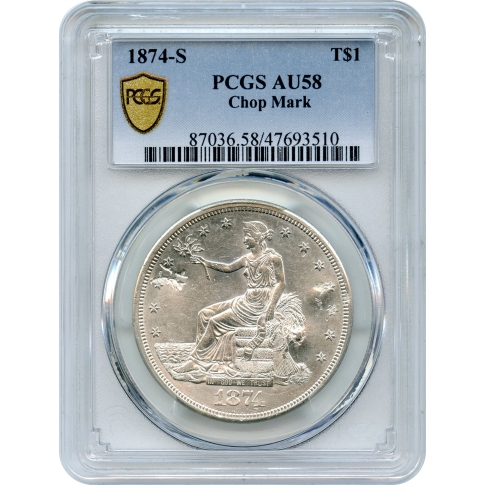1874-S $1 Trade Silver Dollar with Chop Mark PCGS AU58
Would you like to include a decidedly unusual piece in your collection? Well, then how about considering an attractive chopmarked Trade dollar! This piece is rare. Out of its mintage of 2,549,000, PCGS has graded a total of 809 of the 1874-S Trade dollars. However, PCGS has graded only 228 of that figure as “Chop Mark.” That represents a miniscule 0.0089 percent of the original mintage. PCGS has graded 33 as AU58 “Chop Mark” with 71 finer. Collectors Universe prices this issue at $750.00 in AU58 “Chop Mark.”
Trade dollars were produced from 1873-1878 in mint state. Until 1876, they were legal tender in the United States, even though their main purpose was for commerce in China and throughout East Asia. That is why examples of Trade dollars feature chop marks upon them. The vast majority of Trade dollars produced at the San Francisco mint, including those of 1874, were put on ships and sent off to the Orient. Those coins were used in Chinese commerce, however many of them were melted in India. That was because the Chinese sent Trade dollars to the subcontinent as payment for opium. After arriving in India, there were melted and turned into silver rupees.
The Old Silver Mint house at 60 Strand Road, Kolkata, India, where perhaps millions of U.S. Trade dollars, including the 1874-S, arrived as payment for opium. They were melted and turned into silver rupees. Photo: Wikimedia Commons.
The United States business strike silver trade dollars, which were minted from 1873 to 1878, were primarily designed for trade with East Asia, particularly China. Here's why some of these dollars have Chinese characters:
1. **Chop Marks**: The Chinese characters or symbols you see on some silver trade dollars are known as "chop marks." These were made by Chinese merchants and bankers as a way to test the coin's authenticity and silver content. In China, when a coin was accepted in trade, the merchant might stamp it with a small mark or character from a punch or chop. This mark indicated that the coin had been checked and was deemed genuine.
2. **Assurance of Quality**: Since there were many different types of coins circulating in China at the time, and not all of them were of reliable quality or silver content, these chop marks served as a sort of quality assurance. If a coin had several chop marks, it meant multiple merchants or banks had verified its authenticity, which could increase its acceptance and value in trade.
3. **Cultural Practice**: This practice was part of the broader cultural and economic system in China where trust in trade was established through personal or business reputation. Each chop was unique to the merchant or the banking house, much like a signature or a seal.
4. **Circulation in China**: The U.S. Trade Dollar was specifically minted to compete with other foreign silver coins in the Asian market. Because they ended up being widely used in China, many would come back to the U.S. or remain in circulation with these chop marks, indicating their journey through various hands in East Asia.
5. **Collector's Interest**: Today, trade dollars with chop marks are of particular interest to numismatists (coin collectors) because these marks tell a story of the coin's history, travels, and the economic interactions between the U.S. and Asia during that era.
The presence of these marks not only authenticates the coin's passage through China but also adds a layer of historical texture to each piece, making those trade dollars with chop marks unique artifacts of 19th-century global trade.
| PCGS # | 87036 |
|---|---|
| Grading Service | NONE |
| Year of Issue | NONE |
| Grade | NONE |
| Denom Type | N/A |
| Numeric Denomination | T$1 |
| Mint Location | NONE |
| Designation | NONE |
| Circ/UnCirc | Not Specified |
| Strike Type | N/A |
| Holder Variety | Chop Mark |
| Grade Add On | NONE |
| Holder Type | N/A |




